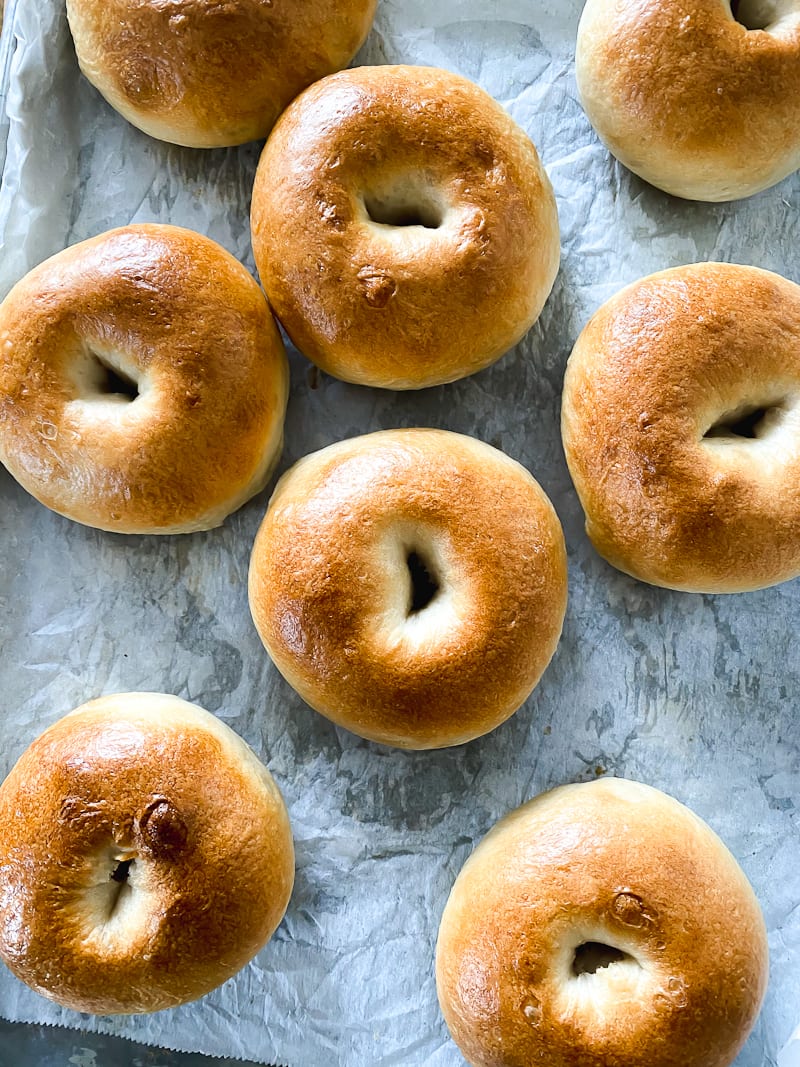Best Sourdough Bagels (Soft, Chewy, Easy!)
This easy sourdough bagel recipe uses active sourdough starter (no yeast) to make soft, chewy, NY-style bagels at home with just 10 minutes of prep and an overnight option to fit your schedule. Customize with everything bagel spice, cinnamon raisin and more. Adapted from my bestselling book: Artisan Sourdough Made Simple.

They’re more flavorful. Less dense. Intensely chewy. You can eat two without time taking nap. The crust is thin and crisp, and the inside is soft (not doughy). I like mine straight from the oven, slathered in salted butter.
This recipe is from my bestselling book, Artisan Sourdough Made Simple, and like everything I teach: it’s practical and straightforward. You’ll find clear step-by-step instructions for mixing, shaping, boiling and baking, plus a flexible timeline to make it work for your schedule. Homemade sourdough bagels sounds hard—but it’s doable. Just read the comment section! You’ll get the best tips from real life bakers who’ve made this recipe hundreds of times.
How To Make Homemade Sourdough Bagels {Step-By-Step Recipe}
Sample Baking Schedule
First, you need a game plan. Sourdough bagels follow several steps, which can be broken down into manageable chunks. I recommend splitting the process over 2 days to utilize the overnight option.
- Saturday night (8:00 PM)
- Mix the dough
- Let rise overnight at 68F
- Note: Hot weather? The dough will rise faster. Skip the overnight rise: do it during the day instead, then chill the bowl overnight once almost doubled. Cold dough is easier to shape.
- Sunday Morning (8:00 AM)
- Shape
- Boil bagels
- Add toppings
- Bake & enjoy warm
Step 1: Mix The Dough
To start: Whisk the water, sourdough starter, and sugar together in a large bowl (the sugar is for balanced flavor—the bagels are not sweet). Then add the flour and salt, and mix to form a rough dough. It will be very stiff. Cover and rest to relax the gluten for 1 hour.
Step 2: Bulk Rise
Cover the dough (or transfer to a high sided dough tub). Let rise overnight at room temperature until airy, puffy, and double in size.
How long should bagel dough rise? At 68 F, plan on 10-12 hrs; at 70 F, about 8-10 hrs.The dough will look lighter, domed, and spring back slowly when pressed lightly with your fingertip. Pay close attention to your specific room temperature. Treat it like an ingredient, and you’ll nail the rise time every time.
Step 3: How To Shape Sourdough Bagels
- Divide the dough into 8 equal pieces, about 115 g each. Use a kitchen scale for uniform size.
- Then roll into balls, and rest for 10-15 minutes on a parchment-lined sheet pan coated with cooking spray. If you forget to spray your pan, your bagels will stick.
- To shape the bagels, poke a hole into the center, then gently stretch and spin to form a ring. This is the fun part! Don’t be afraid to make the hole larger than you think (it will shrink back during proofing and baking).
Step 4: Second Rise
- The bagel dough needs to rise again, but only briefly. Cover and rest until puffy, about 20-30 minutes (I use this sheet pan set w/lid which is a game changer. No more fussing with plastic wrap and kitchen towels!).
- Meanwhile, bring a large pot of water to a boil. Add a spoonful of honey (or barley malt syrup). This step adds golden color and flavor to the crust.
- Preheat your oven. Prep your topping station: add sesame seeds, everything spice, poppy seeds etc. to a rimmed tray or wide bowl.
Step 5: Boil The Bagels
- Gently lower 2-3 bagels into the pot. Once they float, simmer for 30 seconds on each side for a thin crust (my preference), or up to 1 minute per side for a thicker, chewier crust.
- Remove with a large slotted spoon and place onto the sheet pan. They will look lumpy and slightly wet. All normal.
Why boil bagels before baking? It sets the crust early, so the dough doesn’t rise too high like bread. You can’t skip this step—it gives the crust its glossy sheen, chewy texture, and helps the toppings stick too
Step 6: Add Toppings
While the bagels are still warm from boiling and slightly wet, dip the rounded side into your toppings. Leave a few plain (the crust is amazing). If you wait too long and your bagels dry out, the toppings won’t stick
Step 7: Bake The Bagels
Bake your sourdough bagels for 20-25 minutes at 425 F. They should be light, slightly firm to the touch, and deep golden brown when ready. Transfer to a wire rack to cool, but please do yourself a favor and enjoy one warm.
To serve, top with salted butter, veggie cream cheese, smoked salmon etc. Or just eat plain. The choice is yours!
How To Store Sourdough Bagels
Your first batch of sourdough bagels will be gone in a day. Store any leftovers in a plastic bag at room temperature for up to 2 days. Keep in mind, bagels are best when fresh (eventually they’re get rubbery). You can also freeze them whole or sliced. Warm in a low oven or toaster.
- Prep Time: 15 hours
- Cook Time: 20-25 minutes
- Total Time: 0 hours
- Yield: 8 bagels 1x
- Category: Sourdough Bread
- Method: Oven-Baked
- Cuisine: American
- Diet: Vegetarian
Description
With just 10 minutes of prep, this easy, overnight sourdough bagel recipe uses active sourdough starter to create the best soft & chewy NY-style bagel. Customize with zesty everything bagel spice, sesame seeds, cinnamon raisin, and more! Recipe adapted from my bestselling book: Artisan Sourdough Made Simple.
Ingredients
For the Dough
- 150 g (3⁄4 cup) bubbly, active sourdough starter
- 250 g (1 cup plus 2 tsp) warm water (See Notes below for temperature range)
- 24 g (2 tbsp) granulated sugar
- 500 g (4 cups plus 2 tbsp) King Arthur bread flour
- 9 g (1 1⁄2 tsp) fine sea salt
- Cooking spray or oil, (for coating the plastic wrap)
For the water bath
- 20 g (1 tbsp) honey
Toppings
- Mixed seeds, such as poppy, sesame, fennel, flax and sun flower seeds or Everything Bagel Spice.
Notes & Variations
- Water temperature: In winter, I use 85-95 F water (29-35 C) to give the rise a boost. In summer, I use cooler water, about 55- 60 F (13-16 C) to slow down and control the rise.
- Cinnamon raisin variation: add 6 g (2 tsp) of ground cinnamon to the dry ingredients (or try 50/50 ground cinnamon and pumpkin spice). Then make the dough. While the dough is resting in Step #2, soak 80 g (1/2 cup) raisins in warm water to soften. Drain in a fine mesh strainer and pat dry using a paper towel before adding them to the dough.
Instructions
- Make the Dough: In a large bowl, whisk the starter, water, and sugar together with a fork. Add the flour and salt. Combine to form a rough dough, then finish mixing by hand until no lumps of our remain. The dough will be very stiff and dry. Note: it’s important to use a large mixing bowl- this dough is strong and rises quite high. As a mixing alternative, use a stand mixer fitted with the dough hook; run on low speed for 5 to 6 minutes to combine and knead.
- Cover the dough with a very damp towel and let rest for 45 minutes to 1 hour. After the dough has rested, work the mass into a semi-smooth ball, about 15 to 20 seconds.
- Bulk Rise: Cover the bowl with plastic wrap that has been lightly coated in oil to prevent sticking. Let rise until double in size, about 10-12 hrs when the temperature is 68 F (20 C); 8 to 10 hours @ 70°F (21°C). Note: in the summer, rise the dough during the day. Once the dough is almost double in size, cover and chill the whole bowl overnight (it will continue to rise slightly in the fridge). Proceed using the cold dough the following day.
- Shape: Line a sheet pan with a nonstick silicone mat or parchment paper. If using parchment, lightly coat with cooking spray or oil to prevent sticking.
- Remove the dough onto a non- floured work surface. Flatten the dough into a rectangle and divide into 8 equal pieces, about 115 g (4 oz) each. Gather the ends, flip the dough over, and roll each piece into a ball. Let the dough rest on your lined sheet pan for 10 to 15 minutes to relax the gluten.
- Working with one ball of dough at a time, poke a hole straight through the center. Move your finger around in a circular motion to gently stretch the dough until the hole is about the size of a walnut. You can also lift up the dough, insert both index fingers through the center hole, and barrel roll to gently stretch the opening. When finished, place the dough back onto the sheet pan. It’s okay if the hole shrinks slightly. Repeat shaping the remaining dough.
- Second Rise: Cover the dough with a damp towel and let rest at room temperature for 15 to 20 minutes. The dough will puff up only slightly at this stage.
- Meanwhile, bring a medium pot of water to a boil. Add the honey and whisk well to dissolve. Preheat your oven to 425°F (220°C). Add the seeds to a rimmed tray or shallow bowl.
- Boil the bagels: Add 2 to 3 bagels into the pot and simmer for 30 seconds on each side for a thin crust. Note: if using cold dough from the fridge, the bagels might not float to the surface right away. Give them a nudge after 30 seconds or so and be patient. Using a slotted spoon, transfer the bagels back the sheet pan you used earlier, placing them rounded side up.
- Once slightly cool but still wet, dip the rounded side of the bagels into the seeds to coat. Place back onto the sheet pan and finish boiling the rest of the bagels.
- Bake: Place your sheet pan on the center rack. Bake the bagels for about 20 to 25 minutes. Flip them over to briefly cook the bottom side, about 1 to 2 minutes or less. When ready, your bagels will be puffed up, light golden brown, and feel light to the touch. Transfer to a wire rack to cool, but indulge yourself and eat one (or two) warm.
The chewy texture of bagels is best enjoyed when made fresh. Store in a plastic bag at room temperature for up to 2 days. Bagels also freeze well; freeze them whole or sliced, covered in plastic wrap and a layer of foil, for up to 3 months.


